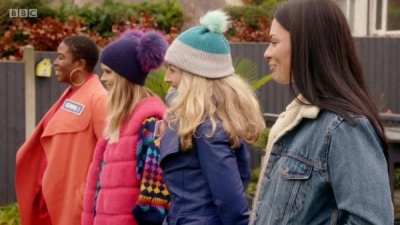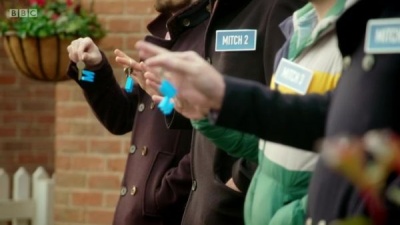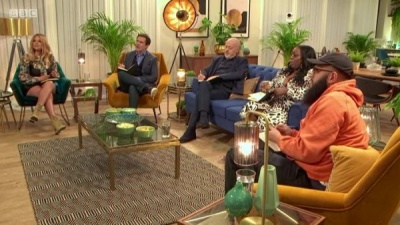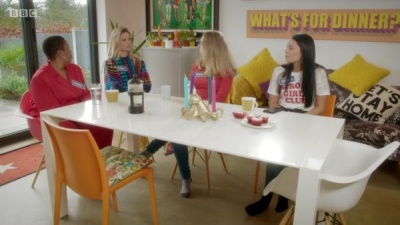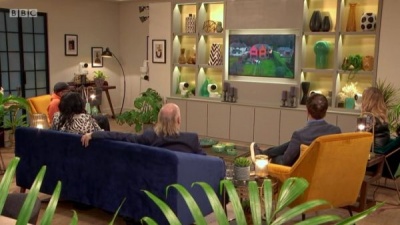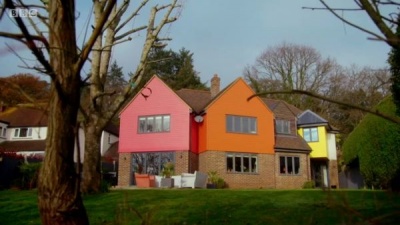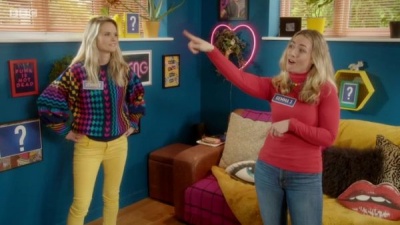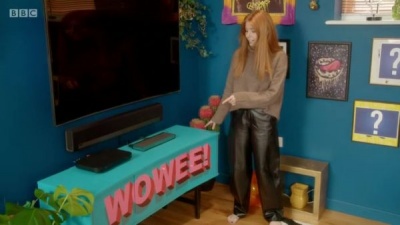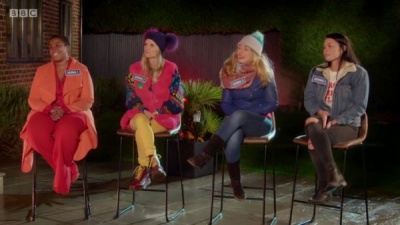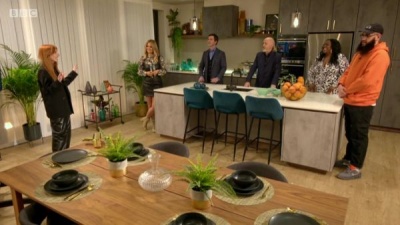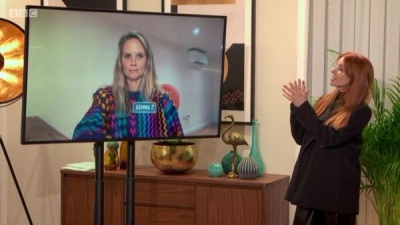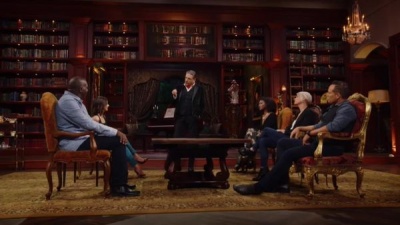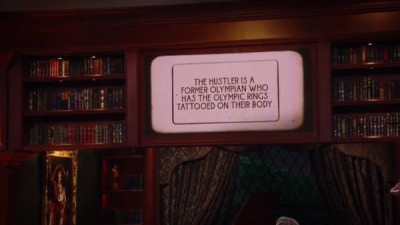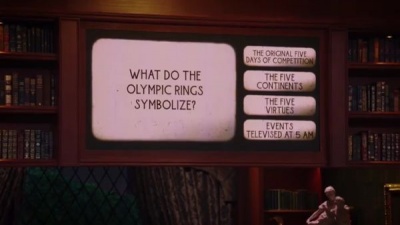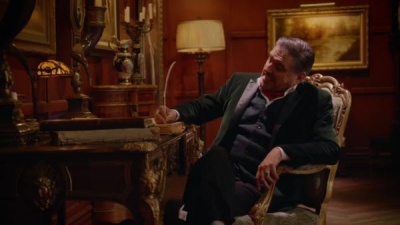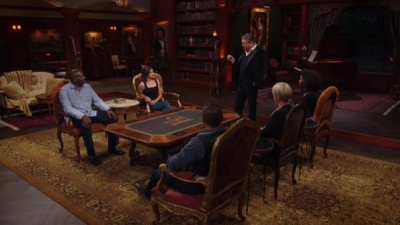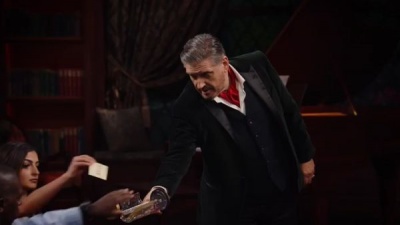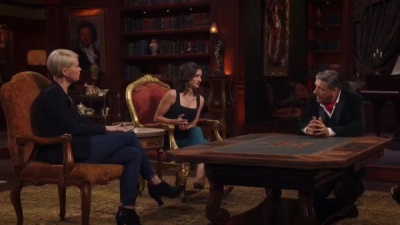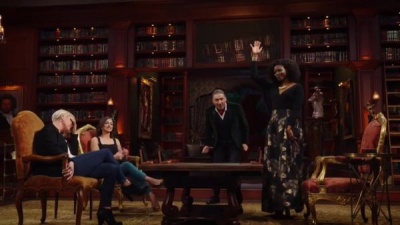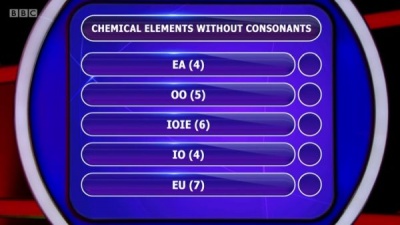Weaver's Week 2021-04-18
Last week | Weaver's Week Index | Next week
"That was rubbish. I'll be tuning in next week."
Two shows from the same creator this week. It's Richard Bacon, who we've not seen in yonks. The Eternal Glory host divides his time between Blighty and California, and makes interesting television wherever he goes.
Contents |
This is My House
Expectation Entertainment, Bacon Media Corporation & Friends Night Inc for BBC1, from 24 March
The basic idea is simplicity itself. Four people say they live in a house. One of them does, the other three are imposters. A panel will try to work out who really lives in the house, and whoever they pick wins a cash prize.
That's it. A format so simple you can write it on a matchbox. How well have they brought this idea to life? Decently well, though with room for improvement.
One improvement can come right at the start. This is My House begins by wasting 86 seconds of our life, with the same sizzle reel every week. Not only is this repetitive, spoileriffic, and a waste of our time, it's not the best possible opening to the show.
How could they do it? The camera walks along a line of four people. As it passes, each says, "I'm Gail Fours, and this is my house." At the end of the line is Stacey Dooley, with a line "Just one of these Gails is telling the truth? Who honestly says, 'this is my house'?"
We'll keep the brief title sequence, and title music. Title sequences and title music are good. Repetitive reels at the beginning of a show are very bad.
So, we have a bunch of owners, and a resident panel. Emily Atack from Celebrity Juice, Judi Love from Loose Women, comedian Jamali Maddix, birdwatcher Bill Bailey. A guest joins the panel every week. These people aren't the stars of the show
This is My House divides into two parts. The first part, which fills about two-thirds of the running time, is an investigation into the various candidates. So we meet the people, hear what brought them to this part of the country. We explore the house, and hear about the people who live here.
And we hear three other stories, fabrications and inventions. Fantasy lives, invented careers, "restoration" of barns, maiden aunts and overpaid bankers. As each Gail tells her story, we cut to confessionals, pieces the contestants recorded to camera away from the others. Are they being honest, or are they influencing the judges?
Ah, the judges. We could have a running commentary from the five main players, but they've rightly chosen not to go down that path. Instead, we cut from the competition house to the judges' lair every few minutes. They recap what they've seen, talk it over amongst themselves.
For the viewer, it's a change of pace, a chance to mentally switch off and not to concentrate quite so hard. If we're getting deeply involved, it's a chance to shout at the telly, berate the judge who insists it's Gail 2 not Gail 3. In other markets, they'd put ad breaks either before or after these moments with the judges.
On the BBC, there are no ad breaks, they've got to fill all 58½ minutes with actual programme content. Inevitably, the well can run a little dry, conversation takes an increasingly surreal turn. But we never know what's around the corner: in an instant, the programme can go from the spectacularly mundane (discussing the qualities of various places where one can buy a leather sofa) to the spectacularly bizarre (licking the leather sofa).
Everything is potentially a clue. Who would keep a corkscrew shaped like that? Not necessarily which person, but what sort of person?
We find our mind wandering and asking what are the influences on This is My House. The obvious antecedent is Through the Keyhole, Lloyd Grossman and David Frost's panel game with lots of subtle clues. But Lloyd never met anyone while he was nosing through the rooms, still less three fake celebrities and one real star. And while there are houses involved, and it's a panel game, that's where the link with Through the Keyhole ends.
What about Who's Doing the Dishes?, a rather fun ITV daytime show from about five years ago. That was a decent game of social deduction, though not one we were allowed to play along with at home. Like This is My House, Who's Doing the Dishes had an excellent ear for music, the grams operator earned his stylus allowance.
No, we reckon the biggest influences here are Gogglebox and Tell the Truth. As you'll know, Gogglebox is a show where we watch people watching telly, and reacting to what they see on the telly. The show's become a massive hit for Channel 4, as popular and as culturally-dominant as Friends was in its 90s heyday.
Tell the Truth goes back even further, to the 1950s. The show brought together four people with a claim to fame: one was telling the truth, the others were making it up as they went along. A panel of celebrities tried to find the real aviator and weed out amphibians with flying goggles.
Some have compared the show to ITV's May the Best House Win and House Gift. We don't see a strong link, this isn't Come Dine with Me But With Houses.
Eventually, after something like half-an-hour of discussions, the show begins to meander towards a conclusion. We might meet Gail's significant other: while he's not allowed to speak or mime or interact at all, he is required to be in the room while four tales are told about him. It's been a gentle show, tempers are never raised, the pace has been gentle and unthreatening, the discussion has perhaps led us to spot glaring holes in Gail 4's story, while the others are implausible and hence quite possible.
Night has fallen, and News at Ten are looking anxiously at their watches. In an effort to bring this show to some sort of conclusion, Stacey Dooley gathers all the Gails in the back garden, and asks rapid-fire questions. What's your takeaway meal? What's the local paper? Who are your neighbours? Who's your MP? Nearest schools? What are the buses like? It's the closest we get to any sort of fast excitement.
After this quickfire interview, the real Gail chooses one of the others to eliminate. The candidates are told this news all together; the remaining players then explain why they've eliminated who they've eliminated. Usually, it's the Gail who's closest to the real homeowner, because the real homeowner wants that £1000 (€1150) for themselves.
The judging panel have a conflab, and discuss who it might be. Via videolink from their shared kitchen, the panel put a question to each Gail in her house. Then they've to decide – unanimously – who the real Gail is.
There's a very genteel hostility at work here. £1000 is a sweetener, enough of a prize to keep the players interested but it's hardly life-changing money. This is My House works because the stakes are so very low: if it were Million Pound This is My House, there would be so much more overt backstabbing. As it is, there might be glowering and strange looks, maybe a little passive-aggressive behaviour, but the show remains light viewing.
Over the weeks, we learn a little more about each of the regular panellists: Emily Atack's hard nose for the truth, Judi's romantic streak, Bill Bailey jumping in with some outlandish theory. It's not the sort of thing we'd associate with 9pm, though: with only a little editing, it's ITV at 3pm, or Channel 4 as a non-quiz at 5pm.
This is My House is a hugely watchable programme. Even if you've got it on as background telly, we can't help but getting drawn in and playing along.
The Hustler
All3Media America / Studio Lambert for ABC (Disney), from 4 January
"A game of secrets, half-truths, and cut-throat competition."
Craig Ferguson is the host, a man with a clipped Scottish accent. He summarises the show's basic dilemma very quickly. We're going to see a series of trivia questions. The players are to work together to solve these questions. They'll be rewarded with $10,000 (£7300, €8400) for each correct answer.
But there's a twist. Of course there's a twist. All of the questions are about the interests and experience of one of the players. This player is the titular "Hustler". Twice during the game, the Hustler will take out one of the other players. After ten questions, if the remaining innocent players can identify the Hustler, they'll split the prize money between them. If they can't, the Hustler takes every last penny.
Craig introduces us to the players, name, location, occupation. The Hustler is entitled to tell fibs throughout the programme, as are the other players – but it's not in the innocent player's interest to tell fibs.
And so we begin. Find out a fact about the Hustler. They've got a tattoo of the Olympic rings on their body. Craig will offer some time for the panel to discuss what they've just learned, this talk may not make it to the final cut. Then we move to the first question: what's the meaning of the Olympic rings? Four possible answers are presented.
The team has 60 seconds to come up with a unanimous answer. Give the right answer, and they add $10,000 to the prize pot. Give a wrong answer – or fail to come up with a unanimous answer – and no money's won. Craig reminds us that the Hustler knows the answer to this question, might they have led the discussion towards the correct answer?
Rinse and repeat for three questions, before the Hustler has a chance to vote someone off the show. All of the players fill out a ballot, marking the player they want to be removed. Four people's votes are ignored: only the Hustler's vote is used. The player they nominated is out of the show at once, barely time for goodbyes.
How do the players leave the show? Through the passage behind the bookcase, obviously. Whose house doesn't have a passage behind the bookcase? The set is carefully decorated, it's absolutely gorgeous. An old study, crushed velvet on the walls, deep armchairs for the players to sit in, low coffee tables, a pneumatic tube. The paintings and bookcases hide display screens, and all of the contestants dress smartly.
Craig Ferguson dresses super-smartly. He has a smoking jacket, a cummerbund, and a sharp line in zingers to keep us all on our toes. At times, he drifts off from the game, sits down at the piano or starts to write a letter with a quill pen. We're reminded of Ed Tudor-Pole's subtle way to enliven a dull game on The Crystal Maze, and that's a very good thing.
Removing players after we've got to know them, based on one person's say so? That happens on This is My House as well, another game where we're trying to find one person in a group. Two swallows don't make a summer, but it does feel like Richard Bacon might have a signature style – find the cuckoo in the nest, in a format we can summarise on the back of a postage stamp.
The Hustler has an unusual method of physical distancing, making sure that people don't go around spreading horrible diseases to each other. Seats are spaced a little closer than we find comfortable here, there are no plastic barriers to cut eyelines. Hope that folk have been tested and come back negative.
The show benefits from a superb soundtrack by Jason Moss, pizzicato strings and careful chimes to help raise tension. Sadly, the show also features some Canned Crowd™, audience reactions added on in post-production. The graphic design is coherent, an ornate mid-century typeface, presented as slide transparencies.
We'll pick up the action going into question 10, the final clue and the final trivia question. Get this question right, and the team's bank will be doubled – 80, 100, 120 grand. Get the question wrong, the bank will be halved, to 20, 25, 30 thousand. The team really don't to lose half their money, but will this extra money help force the Hustler to give the right answer?
After the final question, there's a period of discussion to try and work out who is the Hustler. How have the players performed? Who got the last question right, or wrong? There's a commercial break to calm nerves, and a recap of most of the clues we've seen through the show.
The final decision: each player votes for who they think the Hustler is. After giving their vote, there's a two-minute period for the players to discuss their opinions, and figure out once and for all who the Hustler is. The lights drop, players talk and bicker. There's even a clock on screen for the final minute of the discussion, something absent from the earlier questions.
"Will the real Hustler please stand up?" We get the result, and a quick recap of how the clues relate to the Hustler. It's short, but long enough to answer the nagging questions.
Ratings for The Hustler on ABC have been good, around 3.5 million viewers. For the biggest network television stateside, that's good ratings; for the biggest network television here, it's mediocre-to-average. We reckon the show could easily work over here, perhaps at £2000 per correct answer.
We're not watching The Hustler as a trivia quiz: the questions are a device to help concentrate minds, to drip-feed information to the contestants. No, we're watching The Hustler to play along – like Craig Ferguson, we have no idea who the Hustler is.
The genre of "one of the players has the answer to all questions" has been tried many times before. Historically, it has never been done terribly well, Dirty Rotten Cheater and The Enemy Within rarely rose above OK. By personalising the clues to the target, The Hustler actually makes us care about the mole, and that's a great achievement.
In other news
Pointless returned to BBC1 daytime, its first daytime episodes recorded under the new health restrictions. Bad news for Big Perspex, as competitors are required to form a household bubble of their own. Everyone keeps One Osman (two metres) apart, and it only looks weird during the head-to-head round. Players are given not two, but three bites at the final round: we really hope there aren't any killjoys on the show, because they'd hang around like a bad fish.
And they've taken some of the slack left lying around by Only Connect, with the Missing Consonants round.
Best of the Web: Our good friends at Buzzerblog have finally seen GSN's attempt to Americanise Pointless. Spoiler: it didn't go well.
C21's International Format Awards have taken place. Bake Off won Best Returning Format, which feels quite sensible. Alan Carr took Best Host of a Format for his manful work saving Epic Gameshow (sic) – it wouldn't be as good without him. Best Studio-Based Format award went to Don't, which we find a baffling call. Something called Full Bloom took the Best Competition Reality Format. The Secret Gameshow (sic) took Best Comedy Format.
University Challenge is coming back to NBC, under the name College Bowl. The venerable university quiz has been off air for many years. Teams of three will participate, the host will be local celebrity Peyton Manning. No word yet on the chance of a transatlantic challenge match.
Glow Up comes back (BBC1, Wed), more make-up to make up. There's old episodes of Top Class (CBBC, weekdays). Les Dennis and Bonnie Langford on Pointless Celebrities (BBC1, Sat), Ronan Keating on I Can See Your Voice (BBC1, Sat), and Stephen Mulhern's In for a Penny in Southampton (ITV, Sat). The Epic Game Show format is Name That Tune (ITV, Sat).
Photo credits: Expectation Entertainment, Bacon Media Corporation & Friends Night Inc; All3Media America / Studio Lambert; Remarkable (part of EndemolShineGroup).
To have Weaver's Week emailed to you on publication day, receive our exclusive TV roundup of the game shows in the week ahead, and chat to other ukgameshows.com readers, sign up to our Google Group.


